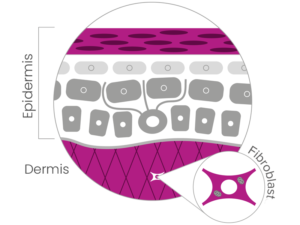The role of hyaluronic acid
Hyaluronic acid is a fundamental polysaccharide in the tissues of our body, capable of absorbing 7 times its volume of water. Filling is the key word for this substance that has become ubiquitous in cosmetic products.
On the skin, it is concentrated in the liquid that lodges between the collagen and elastin fibres of the dermal layer, allowing these fibres to organise and arrange themselves in an orderly and “comfortable” manner and constituting a primordial liquid that in newborns is rich and fresh, but that inevitably becomes less available and poor as the years go by.
It is also very important in maintaining a high level of epidermal hydration, characterising the turgidity and plasticity of the skin surface, which is why creams containing hyaluronic acid temporarily correct surface micro-wrinkles.
The natural producer of hyaluronic acid in our body is a tireless cell called fibroblast that constantly synthesizes, starting from other molecules, this precious substance: the good functioning of fibroblasts is, therefore, the key to an abundant presence of hyaluronic acid.
The MyCli approach
The idea of delivering hyaluronic acid to the skin through topical preparations – creams, serums, lotions, etc – is an easy way to reach the epidermis, fill it up momentarily and make the skin soft. However, the size of this molecule prevents it from passing through the “customs” of our deep tissue which is the dermo-epidermal junction.
Even if low molecular weight hyaluronic acids have been produced, therefore very small, the only way to convey them in the dermis is through injections, the so-called “filler punctures,” which are wisely distributed by the aesthetic doctor and have an average duration of 6/10 months because their content is slowly absorbed and degraded.
From a cosmeceutical point of view, hyaluronic acid “precursors” can be used, i.e. small molecules that chain themselves to others and become hyaluronic acid itself. Among these, N-acetyl-Glucosamine has been studied and used by MyCli to promote the neo formation of HA.
Another front on which it is essential to act is the defense of this substance from its degradation: the enemies of hyaluronic acid are some enzymes such as Hyaluronidase, very frequent in conditions of oxidative stress, and that lead to loss of plasticity and turgidity of tissues and a consequent appearance of wrinkles, loss of dermal tone and dehydration. In order to fight hyaluronidases, MyCli has studied and developed molecules such as caffeilquinic acid, present in the extract of centella asiatica, able to effectively counteract the action of hyaluronidases defending the dermal youth capital.
MyCli formulations
The presence of hyaluronic acid in our formulas in the form of sodium hyaluronate is frequent. In our vision, it is not so much a corrective ingredient as a carrier, a vehicle that facilitates and promotes the penetration of true protective and corrective substances.
The HA-Plast line groups together products specialized in the stimulation and production of dermal hyaluronic acid, the endogenous one, through various different molecules:
– NAG (Acetyl glucosamine): one of the two monomers that make up the acid molecule
hyaluronic acid. In HA-Plast, thanks to its small size (< 500 daltons), it penetrates at the level of
epidermis until it reaches the dermis, where it directly stimulates the production of new acid
hyaluronic acid for a filled, turgid and toned skin.
– CFQ acid (Centella asiatica leaf extract): caffeilquinic acid contained in polyphenols that
characterize the composition of centella asiatica extract. In HA-Plast, thanks to its
high antioxidant capacity, protects the capillary environment by decreasing inflammation,
vasodilation and redness and promoting an even complexion.
– Niacinamide (Niacinamide): vitamin B3 or vitamin PP, an important cofactor of enzymes at
antioxidant activity. Its concentration in HA-Plast promotes the synthesis of filaggrin, inhibits
the cellular inflammation and intervenes in the transfer of melanin from the melanocytes to the layer
for a uniform and homogeneous complexion.
– Haloxyl (N-Hydroxysuccinimide, Chrysin, Palmitoyl oligopeptide, Palmitoyl tetrapeptide-7):
molecular compound characterized by chrysin, N-hydroxysuccinimide and peptides. In HA-Plast,
activates enzymes that eliminate bilirubin typically found around the eye area,
reduces vasodilation and exerts a powerful lightening action on dark circles and protective action
of the fragile periocular connective tissue.
– Tetrapeptide (Acetyl tetrapeptide-2): tetrapeptide that stimulates the production of the structures
fundamental proteins of the dermis such as collagen and elastin. Its presence in HA-Plast
it exerts a powerful anti-gravity action, guaranteeing tonicity, elasticity and plasticity to the skin.
– Hyaspheres (Ethylhexyl palmitate, Trihydroxystearin, Sodium hyaluronate, Glucomannan):
a combination of two highly hygroscopic cross-linked biopolymers, a low level hyaluronic acid and the
molecular weight and a high molecular weight glucomannan polysaccharide. In HA-Plast, their
presence ensures perfect hydration and surface turgidity of the skin.
– Hydroxyproline (Dipalmitoyl hydroxyproline): an amino acid that is directly involved in the
formation of new collagen and protects it from enzymatic degradation. In HA-Plast, it intervenes
supporting the protein structure of the dermal matrix, supporting the filler booster action.
– Wakalipids (Undaria Pinnatifida extract): lipo-extract of the alga Undaria Pinnatifida capable of
to promote the homeostasis of the hydrolipidic film. In HA-Plast it balances the presence of the components
lipophilic epidermis and sebum and promotes the synthesis of physiological moisturizing factors to promote the
tissue rejuvenation.
– Papain (Papain): proteolytic enzyme with exfoliating and superficial keratolytic action.
In HA-Plast it promotes cell turnover for a more even and uniform complexion, it eliminates the
dead cells from the surface of the epidermis counteracting dryness and dehydration wrinkles
and inhibits microbiological growth.
– Urea: physiological molecule that characterizes the epidermal moisturizing factor (NMF).
In HA-Plast, its concentration exerts a deep moisturizing action, softens the layer
and promotes the healing of small superficial cracks and skin elasticity.




